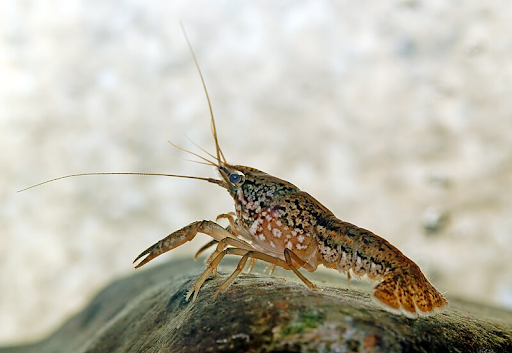The cloning crayfish conundrum: A threat to the Great Lakes ecosystem
While not in the Great Lakes -- yet -- its ability to outcompete native species make the marbled crayfish a significant risk to the Great Lakes.

The Great Lakes, one of North America's most precious natural resources, have long been a source of biodiversity and economic significance. However, in recent years, a new threat has emerged that could potentially disrupt the delicate balance of this ecosystem—the marbled crayfish Procambarus virginalis. Park officials in Burlington City Park, Ontario, reported the first record of this species in North America back in October 2021, a mere 4 miles from Lake Ontario. Although not yet found in the Great Lakes, its rapid reproduction and ability to outcompete native species make the marbled crayfish a significant risk to the biodiversity of the Great Lakes.
The marbled crayfish invasion
The marbled crayfish is a freshwater crustacean native to the aquarium trade with no naturally occurring populations in the wild. It is presumed that the first marbled crayfish was born in an aquarium, with the oldest record being from a German biologist who obtained a batch of uncharacterized crayfish from a pet trader at a trade fair in Germany in 1995. While this crayfish is a popular aquarium specimen, it has gained notoriety for its invasive nature and adaptability, leading to its introduction in various parts of the world. What makes this species particularly concerning is its unique reproductive strategy—parthenogenesis.
Parthenogenesis is a form of asexual reproduction in which females can produce genetically identical offspring without the need for fertilization by males. This ability allows a single marbled crayfish to rapidly populate an area, leading to explosive population growth. Once introduced to a new habitat, the marbled crayfish can quickly establish a thriving population, outcompeting native species for resources.
Economic and ecological consequences
The Great Lakes are home to a diverse array of native flora and fauna, many of which have evolved to coexist in a delicate ecological balance. The introduction of the marbled crayfish can upset this balance, as the species outcompetes native crayfish for food and habitat. The rapid reproduction of marbled crayfish allows them to establish dominance quickly, leading to a decline in native crayfish populations. Additionally, marbled crayfish are omnivores, feeding on a variety of aquatic plants, insects, and small invertebrates. This broad diet further intensifies their impact on the Great Lakes ecosystem, potentially affecting the survival of native species and disrupting the food web.
The invasion of marbled crayfish in the Great Lakes could have far-reaching consequences. Beyond the ecological impact on native species, there are potential economic repercussions. The disruption of the food web could affect commercially valuable fish species, impacting both the fishing industry and the communities that rely on it. Furthermore, the unchecked spread of marbled crayfish could lead to increased maintenance costs for water infrastructure. Their burrowing activities can destabilize shorelines and riverbanks, potentially causing erosion and infrastructure damage.
Preventive measures and management
Efforts to prevent the introduction of marbled crayfish in the Great Lakes are crucial. In Michigan, marbled crayfish is regulated under the Natural Resources Environmental Protection Act and is “unlawful to possess, introduce, import, sell or offer this species for sale as a live organism, except under certain circumstances.” Regulations on the import and possession of this species can help limit its introduction to new areas.
Researchers and conservationists are also exploring management strategies, including the development of biological controls or targeted removal programs to mitigate the impact of marbled crayfish on native species. Early detection and rapid response are essential to prevent the establishment of self-sustaining populations

Suspected marbled crayfish sighting in your area?
Report it to the Nonindigenous Aquatic Species (NAS) program through
the Sighting Report Form.
How to Help
First and foremost, do not release any unwanted aquarium species into local waterways. The dumping of non-native species is considered stocking, and is illegal in Michigan without a permit. While it may seem like a humane way to rehome your crayfish, there may be negative effects for the local environment. If you or someone you know has an unwanted crayfish, there are several responsible alternatives to releasing it locally:
- Attempt to rehome your crayfish. There are many resources available to help rehome an unwanted pet, such as social media groups or online forums.
- Bring your pet to a humane society or attend a Habitattitude™ exotic pet surrender event.
- Donate your crayfish to a local school or education center.
- Talk to your local veterinarian or pet retailer for humane disposal options.
Additional resources
- Marbled crayfish (Procambarus virginalis) Species Profile – An extensive summary of marbled crayfish identification, ecology, and management.
- Habitattitude™ U.S. – The national campaign addressing pet species as aquatic invasive species.
- Don’t Let it Loose – A campaign promoting responsible pet ownership, including resources to help you rehome an unwanted pet, supported by the US Fish and Wildlife Service.
- Reduce Invasive Pet and Plant Escapes (RIPPLE) - Education initiatives coordinated by Michigan State University Extension, the program offers information to aquarium and water gardener professionals, retailers and hobbyists about what to do with unwanted plants and animals.
Michigan Sea Grant helps to foster economic growth and protect Michigan’s coastal, Great Lakes resources through education, research and outreach. A collaborative effort of the University of Michigan and Michigan State University and its MSU Extension, Michigan Sea Grant is part of the NOAA-National Sea Grant network of 34 university-based programs.
This article was prepared by Michigan Sea Grant under award NA22OAR4170084 from the National Oceanic and Atmospheric Administration, U.S. Department of Commerce through the Regents of the University of Michigan. The statement, findings, conclusions, and recommendations are those of the author(s) and do not necessarily reflect the views of the National Oceanic and Atmospheric Administration, the Department of Commerce, or the Regents of the University of Michigan.



 Print
Print Email
Email

